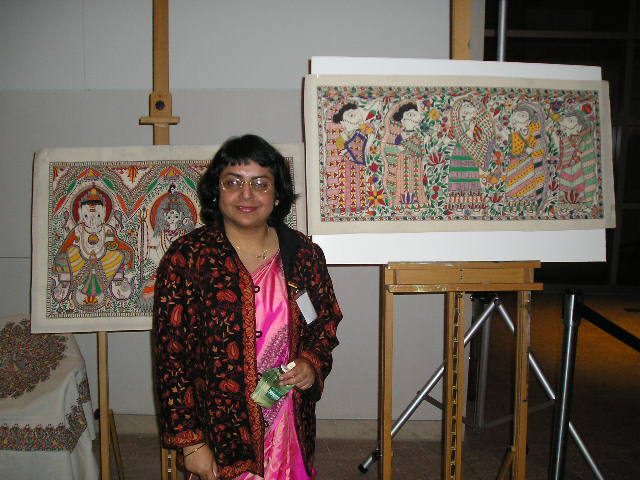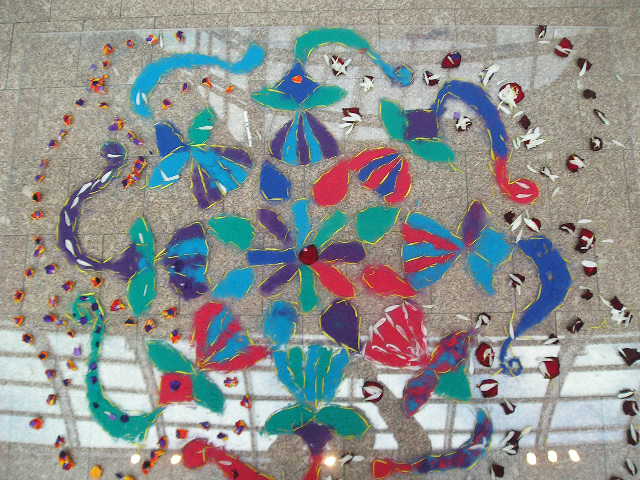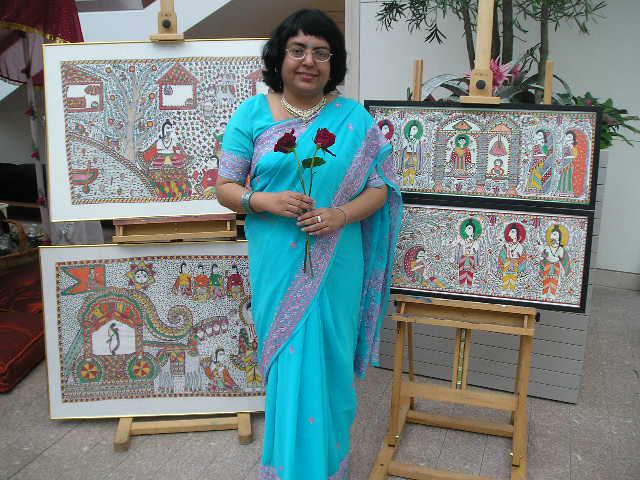
Archives
Contribute
| South Asian Art History - In Memory Of Prashant H. Fadia |
Sunanda Sahay
04/13/2007
Madhubani,
or Mithila painting is a folk painting of northern India. It literally
means 'forest of honey'. Its heritage dates back to at least 2,500
years when the earth of northern India was covered with dense forests.
Life was full of hardships, and the abundance of honey was most likely
a primary source of happiness.
The area of Mithila lies near the
border of India and Nepal, and carries a rich cultural legacy in art
and literature. It is also the birthplace of Sita, the central
character in Ramayana. Hence, her life and marraige are frequently
depicted in local art.
The art of Madhubani depicts images
of of gods and goddesses, herows and heroines, from the Rmayana
and Mahabharata. It is mostly practiced by village women, who have
passed this art to their daughters, generation after generation. They
paint images of nature and various cycles of life including birth and
marraige. Even though this folk art has been practived for centuries,
it has not received the recognition it deserves, largely due to the
fact that artists have not always received enough support to promote
their art.
Even thou this art is centuries old, it has
preserved its original style and content. In contemporary Madhubani all
kinds of colors are used, but traditional artists still make theie own
colors by extracting natural dyes from plants. The coloring is of two
styles - Kachni (hatching) and Bharni (shading). Kachni uses delicte
fine lines to fill the painting and not much color is used. Bharni uses
solid colors to shade and fill the pictures, as well as black outlines
filled with vibrant colors. A variety of inventive patterns are made
with hatching and stippling. Even now during birth and marraige
ceremonies paintings are made on walls with different symbols like
bamboo (lineage), lotus and fish. The designs announce the occasion of
the celebration and solicit goofd fortune and divine blessings.
In this folk art, the numan figure becomes devine. For example:
- The head is given a big ey for vision
- The torso is elongated to show strength
- The arms are multiplied for power
- The legs are stretched for alertness
- Birds and flowers enliven the poetry of life
The practive of silling the canvas with abundant imageryand use of
bright colors in the paintings portrays the liveliness of the people of
the Madhubani region.
Sunanda Sahay grew up in the
Darbhanga, the heart of the Madhubani region. Artistic interests led
Sunanda to seek out practitioners of the art from local villages and
learn directly from them. Sunanda's works have stayed true to the
traditional themes of religious stories and social customs, and her
style has not deviated from the dense, arching, and brightly colored
strokes characteristic of the art. After earning a Maters in English
literature, Sunanda now lives in Acton, MA with her two sons and
husband.
You may also access this article through our web-site http://www.lokvani.com/


